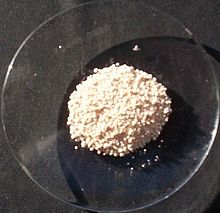Hafnium(IV) oxide

| |

| |
| Names | |
|---|---|
| IUPAC name
Hafnium(IV) oxide
| |
| Other names
Hafnium dioxide
Hafnia | |
| Identifiers | |
3D model (
JSmol ) |
|
| ChemSpider | |
ECHA InfoCard
|
100.031.818 |
| EC Number |
|
PubChem CID
|
|
| UNII | |
| |
| |
| Properties | |
| HfO2 | |
| Molar mass | 210.49 g/mol |
| Appearance | off-white powder |
| Density | 9.68 g/cm3, solid |
| Melting point | 2,758 °C (4,996 °F; 3,031 K) |
| Boiling point | 5,400 °C (9,750 °F; 5,670 K) |
| insoluble | |
| −23.0·10−6 cm3/mol | |
| Hazards | |
| Flash point | Non-flammable |
| Related compounds | |
Other cations
|
Zirconium(IV) oxide
|
Related compounds
|
Hafnium nitride |
Except where otherwise noted, data are given for materials in their standard state (at 25 °C [77 °F], 100 kPa).
| |
Hafnium(IV) oxide is the
Hafnium(IV) oxide is quite inert. It reacts with strong acids such as concentrated sulfuric acid and with strong bases. It dissolves slowly in hydrofluoric acid to give fluorohafnate anions. At elevated temperatures, it reacts with chlorine in the presence of graphite or carbon tetrachloride to give hafnium tetrachloride.
Structure
Hafnia typically adopts the same structure as zirconia (ZrO2). Unlike TiO2, which features six-coordinate Ti in all phases, zirconia and hafnia consist of seven-coordinate metal centres. A variety of other crystalline phases have been experimentally observed, including cubic fluorite (Fm3m), tetragonal (P42/nmc), monoclinic (P21/c) and orthorhombic (Pbca and Pnma).[2] It is also known that hafnia may adopt two other orthorhombic metastable phases (space group Pca21 and Pmn21) over a wide range of pressures and temperatures,[3] presumably being the sources of the ferroelectricity observed in thin films of hafnia.[4]
Thin films of hafnium oxides deposited by
Applications
Hafnia is used in
Hafnium oxide (as well as doped and oxygen-deficient hafnium oxide) attracts additional interest as a possible candidate for resistive-switching memories
Because of its very high melting point, hafnia is also used as a refractory material in the insulation of such devices as thermocouples, where it can operate at temperatures up to 2500 °C.[14]
Multilayered films of hafnium dioxide, silica, and other materials have been developed for use in passive cooling of buildings. The films reflect sunlight and radiate heat at wavelengths that pass through Earth's atmosphere, and can have temperatures several degrees cooler than surrounding materials under the same conditions.[15]
References
- .
- .
- S2CID 53347579.
- .
- .
- S2CID 7806254.
- Intel (11 November 2007). "Intel's Fundamental Advance in Transistor Design Extends Moore's Law, Computing Performance".
- doi:10.1063/1.1361065.), Table 1
{{cite journal}}: CS1 maint: multiple names: authors list (link - .
- Imec (7 June 2017). "Imec demonstrates breakthrough in CMOS-compatible Ferroelectric Memory".
- ^ The Ferroelectric Memory Company (8 June 2017). "World's first FeFET-based 3D NAND demonstration".
- ISBN 978-1-4577-0505-2.
- ^ Nivole Ahner (August 2018). Mit HFO2 voll CMOS-kompatibel (in German). Elektronik Industrie.
- ^ Very High Temperature Exotic Thermocouple Probes product data, Omega Engineering, Inc., retrieved 2008-12-03
- ^ "Aaswath Raman | Innovators Under 35 | MIT Technology Review". August 2015. Retrieved 2015-09-02.
